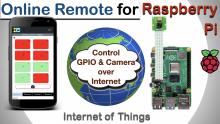Free Remote Access Solutions For Raspberry Pi OS: A Comprehensive Guide
Introduction to Pi Remote Free
Remote access to your Raspberry Pi has never been easier, thanks to the various free tools and methods available today. Whether you're a hobbyist tinkering with projects or a developer managing headless configurations, being able to control your Raspberry Pi remotely is essential. This article will walk you through some of the best free solutions for remote access, including SSH, VNC, Raspberry Pi Connect, and more. By the end of this guide, you'll have a clear understanding of how to set up and use these methods effectively.
Why Use Remote Access for Raspberry Pi?
Using a remote desktop is a convenient way to control your Raspberry Pi from another computer. This setup allows you to follow tutorials, manage files, and even develop software without needing physical access to your device. Additionally, remote access makes it easier to troubleshoot issues or monitor your Pi’s performance from anywhere in the world.
Here are some common reasons why people use remote access:
- To control Raspberry Pi from any device connected to the internet.
- To write code and modify your Raspberry Pi in a headless configuration.
- To manage projects and devices connected to the GPIO pins.
- To browse, send emails, edit text, or control media players remotely.
Methods for Free Remote Access
1. Secure Shell (SSH)
SSH (Secure Shell) is one of the most popular methods for remote access to Raspberry Pi. It provides a secure and encrypted connection to your device, allowing you to send commands and manage files from any computer with an SSH client. SSH is ideal for developers and advanced users who prefer command-line interfaces.
To use SSH:
- Enable SSH on your Raspberry Pi by running
sudo raspi-configand navigating to the SSH option. - Find the IP address of your Raspberry Pi using
ifconfigorip addr. - Connect to your Raspberry Pi from another computer using an SSH client like PuTTY (Windows) or the terminal (Mac/Linux).
2. Virtual Network Computing (VNC)
VNC is a graphical desktop-sharing system that allows you to control your Raspberry Pi remotely. With VNC, you can see your Raspberry Pi's desktop and interact with it as if you were sitting right in front of it. This method is perfect for users who prefer a graphical interface over the command line.
To set up VNC:
- Install the VNC server on your Raspberry Pi by enabling it in
raspi-config. - Download and install a VNC client on your computer or mobile device.
- Connect to your Raspberry Pi using its IP address or hostname.
3. Raspberry Pi Connect
Raspberry Pi Connect is a new solution for remote access that allows you to directly access your Raspberry Pi through a web browser. This method eliminates the need for additional software or complex configurations. With Raspberry Pi Connect, you can manage your Pi from any device with an internet connection.
Key features of Raspberry Pi Connect:
- Access your Raspberry Pi’s desktop via a web browser.
- Supports secure connections without exposing your Pi to the open internet.
- Two methods of access: direct browser access and secure tunneling.
4. Third-Party Tools
Beyond the built-in tools, several third-party solutions offer free remote access to your Raspberry Pi. These include:
- TeamViewer: A popular remote desktop software that provides easy and secure access.
- NoMachine: A lightweight and efficient remote desktop solution that offers excellent performance.
- Splashtop: A user-friendly remote desktop tool that is free for personal use.
- Platforms like Ngrok and Dataplicity: These platforms create secure tunnels to your Raspberry Pi, enabling remote access without complex configurations.
Best Practices for Secure Remote Access
While remote access is convenient, it's crucial to prioritize security. Here are some best practices to keep your Raspberry Pi safe:
- Use strong passwords and enable two-factor authentication (if supported).
- Keep your Raspberry Pi OS and all installed software up to date.
- Avoid exposing SSH or VNC directly to the open internet; instead, use a secure tunnel or a VPN.
- Limit access to trusted devices and IP addresses whenever possible.
Step-by-Step Guide to Setting Up Remote Access
Now that you know the methods and tools available, let's walk through setting up remote access for your Raspberry Pi:
Step 1: Install Raspberry Pi OS
Before setting up remote access, ensure you have Raspberry Pi OS installed on your device. You can download and install it using Raspberry Pi Imager, which is a quick and easy way to set up your Pi.
Step 2: Enable SSH or VNC
Depending on your preferred method, enable SSH or VNC on your Raspberry Pi. This can be done through raspi-config or by manually editing configuration files.
Step 3: Connect to Your Raspberry Pi
Use an SSH client or VNC viewer to connect to your Raspberry Pi. If you're using Raspberry Pi Connect, simply open a web browser and enter the provided URL.
Step 4: Test and Secure Your Connection
Once connected, test your setup to ensure everything works as expected. Then, secure your connection by following the best practices mentioned earlier.
Conclusion
Remote access to your Raspberry Pi is an invaluable tool for both hobbyists and developers. Whether you choose SSH, VNC, Raspberry Pi Connect, or a third-party solution, there are plenty of free options available to suit your needs. This guide has covered the essential methods, tools, and best practices for achieving remote access to your Raspberry Pi.
By following the steps outlined in this article, you can confidently set up and use remote access for your Raspberry Pi. Remember to prioritize security and regularly update your system to protect against potential threats. With these tools at your disposal, you're ready to take your Raspberry Pi projects to the next level!

Robotics | Internet of Things | Home Automation

Remote Control

Remote For Kodi On Raspberry Pi – Raspberry